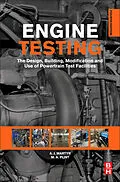One of few books dedicated to engine testing and a true, recognized market-leader on the subject
Covers all key aspects of this large topic, including test-cell design and setup, data management, and dynamometer selection and use, with new chapters on hybrid testing, OBD (on-board diagnostics) and sensor signals from modern engines
Brings together otherwise scattered information on the theory and practice of engine testing into one up-to-date reference for automotive engineers who must refer to such knowledge on a daily basis
A.J. Martyr has held senior technical positions with several of the major test plant manufacturers and consultancy firms over the last 40 years. He is now Honorary Visiting Professor of Powertrain Engineering at Bradford University.
M.A.Plint died in November 1998, four days after the publication of the second edition and after a long and distinguished career in engineering and authoriship.
Autorentext
A.J. Martyr has held senior technical positions with several of the major test plant manufacturers and consultancy firms over the last 40 years. He is now Honorary Visiting Professor of Powertrain Engineering at Bradford University.
Leseprobe
Introduction
This book is not intended to be exclusively of interest to automotive engineers, either in training or in post, although they have formed the majority of the readership of previous editions. It is intended to be of assistance to those involved not only with the actual testing of engines, powertrains and vehicles, but also with all aspects of projects that involve the design, planning, building, and major modernization of engine and powertrain test facilities.
We are today (2011) at a significant break in the continuity of automotive engine and powertrain development. Such is the degree of system integration within the modern vehicle, marine, and generating machinery installations that the word "engine" is now frequently replaced in the automotive industries by the more general term "powertrain".
So, while much of this book is concerned with the design, construction, and use of facilities that test internal combustion engines, the boundaries of what exactly constitutes the primary automotive IC power source is becoming increasingly indistinct as hybridization, integration of electrical drives, and fuel cell systems are developed.
The unit under test (UUT) in most cells today, running automotive engines, has to either include actual or simulated vehicle parts and controllers, not previously thought of as engine components. This volume covers the testing of these evolving powertrain technologies, including transmission modules, in so far as they affect the design and use of automotive test facilities.
Drivers' perception of their vehicle's performance and its drivability is now determined less by its mechanical properties and more by the various software models residing in control systems interposed between the driver and the vehicle's actuating hardware. Most drivers are unaware of the degree to which their vehicles have become "drive by wire", making them, the driver, more of a vehicle commander than a controller. In the latter role the human uses the vehicle controls, including the accelerator pedal, to communicate his or her intention, but it is the engine control unit (ECU), calibrated and mapped in the test cell, that determines how and if the intention is carried out. In the lifetime of this volume this trend will develop to the point, perhaps, where driver behavior is regionally constrained.
Twenty years ago drivability attributes were largely the direct result of the mechanical configuration of the powertrain and vehicle. Drivability and performance would be tuned by changing that configuration, but today it is the test engineers and software developers that select and enforce, through control "maps", the powertrain and vehicle characteristics.
In all but motor sport applications the primary criteria for the selected performance maps are those of meeting the requirements of legislative tests, and only secondarily the needs of user profiles within their target market.
Both US and European legislation is now requiring the installation, in new light vehicles, of vehicle stability systems that, in a predetermined set of circumstances, judge that the driver is about to lose control or, in conditions that are outside a pre-programmed norm, intervenes and, depending on one's view, either takes over powertrain control and attempts to "correct" the driver's actions, or assists the driver to keep a conventional model of vehicle control.
A potential problem with these manufacturer-specific, driver assistance systems is their performance in abnormal conditions, such as deep snow or corrugated sand, when drivers, few of whom ever read the vehicle user manual, may be unaware of how or if the systems should be switched on or off.
Similarly, on-board diagnostic (OBD) systems are becoming mandatory worldwide but their capabilities and roles are far exceeding the legislatively required OBD-11 monitoring of the performance of the exhaust
